【Android UI设计与开发】4.底部菜单栏(一)Fragment介绍和简单实现
TabActivity在Android4.0以后已经被完全弃用,取而代之的是Fragment。Fragment是Android3.0新增的概念,Fragment翻译成中文是碎片的意思,不过却和Activity十分的相似。以下内容适用于3.0及以上的版本,3.0以下就不再赘述。
官方文档地址:http://developer.android.com/reference/android/support/v4/app/Fragment.html
一、Fragment的基础知识介绍
1.Fragment的特性
Android是在Android 3.0 (API level 11)开始引入Fragment的。
可以把Fragment想成Activity中的模块,这个模块有自己的布局,有自己的生命周期,单独处理自己的输入,在Activity运行的时候可以加载或者移除Fragment模块。
可以把Fragment设计成可以在多个Activity中复用的模块。
当开发的应用程序同时适用于平板电脑和手机时,可以利用Fragment实现灵活的布局,改善用户体验。如图:
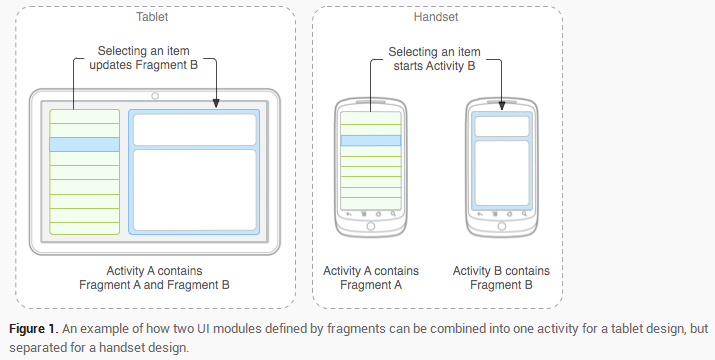
2 .Fragment的生命周期
因为Fragment必须嵌入在Acitivity中使用,所以Fragment的生命周期和它所在的Activity是密切相关的。
如果Activity是暂停状态,其中所有的Fragment都是暂停状态;如果Activity是stopped状态,这个Activity中所有的Fragment都不能被启动;如果Activity被销毁,那么它其中的所有Fragment都会被销毁。
但是,当Activity在活动状态,可以独立控制Fragment的状态,比如加上或者移除Fragment。
当这样进行fragment transaction(转换)的时候,可以把fragment放入Activity的back stack中,这样用户就可以进行返回操作。
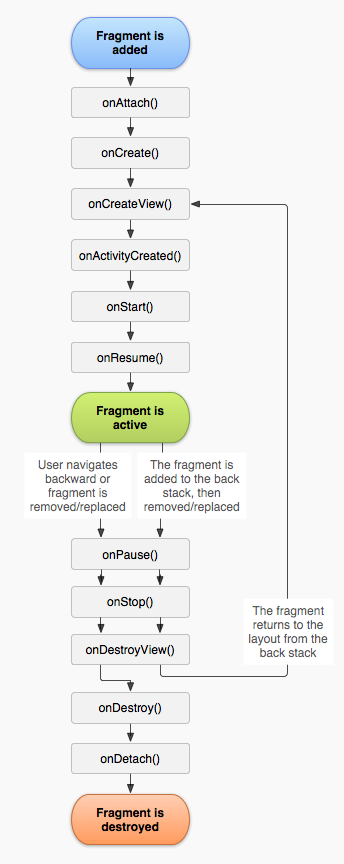
3.Fragment的使用相关
使用Fragment时,需要继承Fragment或者Fragment的子类(DialogFragment, ListFragment, PreferenceFragment, WebViewFragment),所以Fragment的代码看起来和Activity的类似。
(1)使用Support Library
Support Library是一个提供了API库函数的JAR文件,这样就可以在旧版本的Android上使用一些新版本的APIs。
比如android-support-v4.jar,它的完整路径是:<sdk>/extras/android/support/v4/android-support-v4.jar.

它就提供了Fragment的APIs,使得在Android 1.6 (API level 4)以上的系统都可以使用Fragment。
为了确定没有在旧版本系统上使用新版本的APIs,需要如下导入语句:
import android.support.v4.app.Fragment;
import android.support.v4.app.FragmentManager;
同时应该将上述的包拷入libs项目下的libs文件夹,然后在项目的Properties中添加:右键单击项目,选Properties,左边选Java Build Path,然后Add External JARs…,添加android-support-v4.jar.
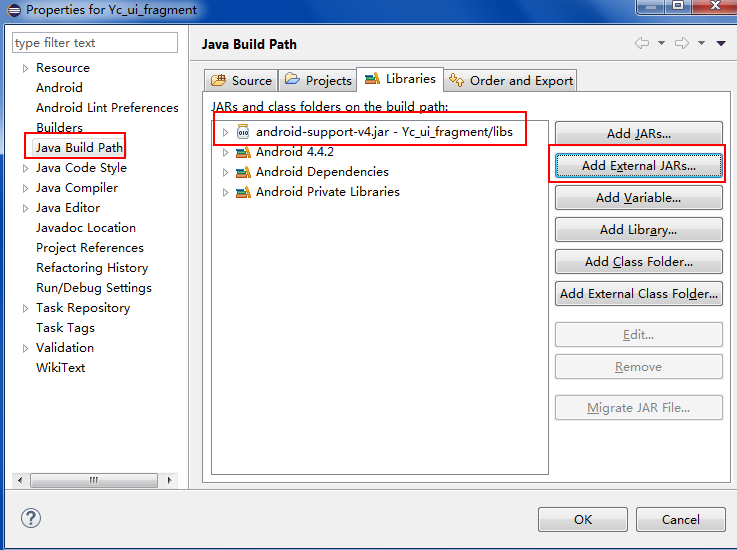
当创建包含Fragment的Activity时,如果用的是Support Library,那么继承的就应该是FragmentActivity而不是Activity。
(2)一般必须实现的三个回调函数
onCreate()
系统在创建Fragment的时候调用这个方法,这里应该初始化相关的组件,一些即便是被暂停或者被停止时依然需要保留的东西。
onCreateView()
当第一次绘制Fragment的UI时系统调用这个方法,必须返回一个View,如果Fragment不提供UI也可以返回null。
注意,如果继承自ListFragment,onCreateView()默认的实现会返回一个ListView,所以不用自己实现。
onPause()
当用户离开Fragment时第一个调用这个方法,需要提交一些变化,因为用户很可能不再返回来。
(3)实现Fragment的UI
提供Fragment的UI,必须实现onCreateView()方法。
假设Fragment的布局设置写在frag_list.xml资源文件中,那么onCreateView()方法可以如下写:
public class FragementList extends Fragment{
/**
* 显示指定的视图
* @inflater resource ID,指明了当前的Fragment对应的资源文件
* @container 该Fragment在Activity中的父容器控件
* @savedInstanceState 是否连接该布局和其父容器控件,在这里的情况设置为false,因为系统已经插入了这个布局到父控件,设置为true将会产生多余的一个View Group。
*/
@Override
public View onCreateView(LayoutInflater inflater, ViewGroup container,
Bundle savedInstanceState) {
return inflater.inflate(R.layout.frag_list, container, false);
}
}
(4)把Fragment加入Activity
当Fragment被加入Activity中时,它会处在对应的View Group中。
Fragment有两种加载方式:一种是在Activity的layout中使用标签<fragment>声明;另一种方法是在代码中把它加入到一个指定的ViewGroup中。
另外,Fragment它可以并不是Activity布局中的任何一部分,它可以是一个不可见的部分。
加载方式1:通过Activity的布局文件将Fragment加入Activity
在Activity的布局文件中,将Fragment作为一个子标签加入即可。
<LinearLayout xmlns:android="http://schemas.android.com/apk/res/android"
android:layout_width="match_parent"
android:layout_height="match_parent"
android:baselineAligned="false"
android:orientation="horizontal" > <fragment
android:id="@+id/frag_list"
android:name="com.yanis.ui.FragementList"
android:layout_width="wrap_content"
android:layout_height="match_parent"
android:layout_weight="1" /> <fragment
android:id="@+id/frag_detail"
android:name="com.yanis.ui.FragementDetails"
android:layout_width="wrap_content"
android:layout_height="match_parent"
android:layout_weight="2" /> </LinearLayout>
其中android:name属性填上创建的fragment的完整类名。
当系统创建这个Activity的布局文件时,系统会实例化每一个fragment,并且调用它们的onCreateView()方法,来获得相应fragment的布局,并将返回值插入fragment标签所在的地方。
有三种方法为Fragment提供ID:
android:id属性:唯一的id
android:tag属性:唯一的字符串
如果上面两个都没提供,系统使用容器view的ID。
加载方式2:通过编程的方式将Fragment加入到一个ViewGroup中
当Activity处于Running状态下的时候,可以在Activity的布局中动态地加入Fragment,只需要指定加入这个Fragment的父View Group即可。
首先,需要一个FragmentTransaction实例:
FragmentManager fragmentManager = getFragmentManager()
FragmentTransaction fragmentTransaction = fragmentManager.beginTransaction();
(注,如果import android.support.v4.app.FragmentManager;即用的是Support Library,那么使用的是:FragmentManager fragmentManager = getSupportFragmentManager();)
之后,用add()方法加上Fragment的对象:
ExampleFragment fragment = new ExampleFragment();
fragmentTransaction.add(R.id.fragment_container, fragment);
fragmentTransaction.commit();
其中第一个参数是这个fragment的容器,即父控件组。
最后需要调用commit()方法使得FragmentTransaction实例的改变生效。
4.来个简单栗子吧
方式一:通过Activity的布局文件将Fragment加入Activity
效果图如下:
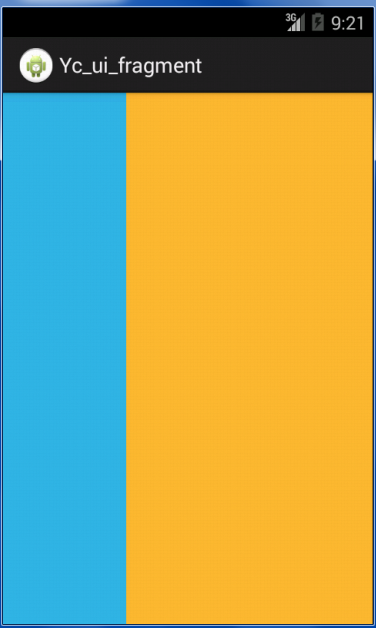
布局文件如下:
<LinearLayout xmlns:android="http://schemas.android.com/apk/res/android"
android:layout_width="match_parent"
android:layout_height="match_parent"
android:baselineAligned="false"
android:orientation="horizontal" > <fragment
android:id="@+id/frag_list"
android:name="com.yanis.ui.FragementList"
android:layout_width="wrap_content"
android:layout_height="match_parent"
android:layout_weight="1" /> <fragment
android:id="@+id/frag_detail"
android:name="com.yanis.ui.FragementDetails"
android:layout_width="wrap_content"
android:layout_height="match_parent"
android:layout_weight="2" /> </LinearLayout>
方式二:通过编程的方式将Fragment加入到一个ViewGroup中
效果图如下:
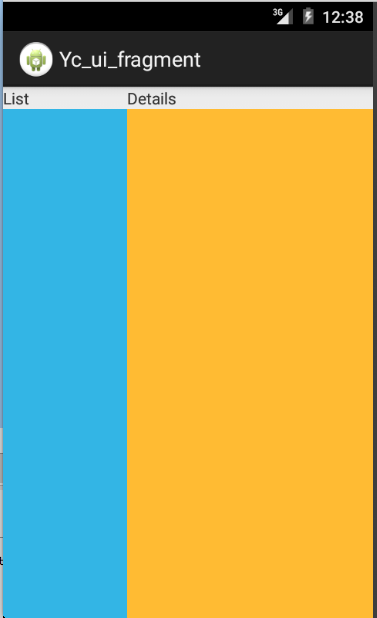
1.主页面布局文件如下
<LinearLayout xmlns:android="http://schemas.android.com/apk/res/android"
android:layout_width="match_parent"
android:layout_height="match_parent"
android:baselineAligned="false"
android:orientation="horizontal" > <LinearLayout
android:id="@+id/frag_list"
android:layout_width="wrap_content"
android:layout_height="match_parent"
android:layout_weight="1" android:orientation="vertical"> <TextView
android:layout_width="match_parent"
android:layout_height="wrap_content"
android:text="List" />
</LinearLayout> <LinearLayout
android:id="@+id/frag_detail" android:orientation="vertical"
android:layout_width="wrap_content"
android:layout_height="match_parent"
android:layout_weight="2" > <TextView
android:layout_width="match_parent"
android:layout_height="wrap_content"
android:text="Details" />
</LinearLayout> </LinearLayout>
2.Activity类代码如下:
package com.yanis.ui; import android.os.Bundle;
import android.support.v4.app.FragmentActivity;
import android.support.v4.app.FragmentManager;
import android.support.v4.app.FragmentTransaction; public class MainActivity extends FragmentActivity { @Override
protected void onCreate(Bundle savedInstanceState) {
super.onCreate(savedInstanceState);
//setContentView(R.layout.activity_main); setContentView(R.layout.activity_maino);
FragmentManager fragmentManager = getSupportFragmentManager();
FragmentTransaction fragmentTransaction = fragmentManager
.beginTransaction();
FragementList fragment1 = new FragementList();
fragmentTransaction.add(R.id.frag_list, fragment1);
FragementDetails fragment2 = new FragementDetails();
fragmentTransaction.add(R.id.frag_detail, fragment2);
fragmentTransaction.commit();
}
}
源代码地址:https://github.com/YeXiaoChao/Yc_ui_fragment
【Android UI设计与开发】4.底部菜单栏(一)Fragment介绍和简单实现的更多相关文章
- 【Android UI设计与开发】第05期:引导界面(五)实现应用程序只启动一次引导界面
[Android UI设计与开发]第05期:引导界面(五)实现应用程序只启动一次引导界面 jingqing 发表于 2013-7-11 14:42:02 浏览(229501) 这篇文章算是对整个引导界 ...
- 【转】【Android UI设计与开发】之详解ActionBar的使用,androidactionbar
原文网址:http://www.bkjia.com/Androidjc/895966.html [Android UI设计与开发]之详解ActionBar的使用,androidactionbar 详解 ...
- 【Android UI设计与开发】5.底部菜单栏(二)使用Fragment实现底部菜单栏
既然 Fragment 取代了TabActivity,当然 TabActivity 的能实现的菜单栏,Fragment 当然也能实现.主要其实就是通过菜单栏的点击事件切换 Fragment 的显示和隐 ...
- 【Android UI设计与开发】第02期:引导界面(二)使用ViewPager实现欢迎引导页面
本系列文章都会以一个程序的实例开发为主线来进行讲解,以求达到一个循序渐进的学习效果,这样更能加深大家对于程序为什么要这样写的用意,理论加上实际的应用才能达到事半功倍的效果,不是吗? 最下方有源码的下载 ...
- 【Android UI设计与开发】8.顶部标题栏(一)ActionBar 奥义·详解
一.ActionBar介绍 在Android 3.0中除了我们重点讲解的Fragment外,Action Bar也是一个非常重要的交互元素,Action Bar取代了传统的tittle bar和men ...
- 【Android UI设计与开发】第01期:引导界面(一)ViewPager介绍和使用详解
做Android开发加起来差不多也有一年多的时间了,总是想写点自己在开发中的心得体会与大家一起交流分享.共同进步,刚开始写也不知该如何下手,仔细想了一下,既然是刚开始写,那就从一个软件给人最直观的感受 ...
- 【Android UI设计与开发】8.顶部标题栏(一)ActionBar 奥义·详解
一.ActionBar介绍 在Android 3.0中除了我们重点讲解的Fragment外,Action Bar也是一个非常重要的交互元素,Action Bar取代了传统的tittle bar和men ...
- 【Android UI设计与开发】3.引导界面(三)实现应用程序只启动一次引导界面
大部分的引导界面基本上都是千篇一律的,只要熟练掌握了一个,基本上也就没什么好说的了,要想实现应用程序只启动一次引导界面这样的效果,只要使用SharedPreferences类,就会让程序变的非常简单, ...
- android UI设计及开发
一.viewPager实现左右滑动及导引功能 1,如果每个屏幕只是一个简单的布局,如果简单的话,定义一个arraryIist<View>,利用addview将所有的布局加载, 然后为vie ...
随机推荐
- Unsupervised Classification - Sprawl Classification Algorithm
Idea Points (data) in same cluster are near each others, or are connected by each others. So: For a ...
- 三、动态SQL语句
//备注:该博客引自:http://limingnihao.iteye.com/blog/106076 有些时候,sql语句where条件中,需要一些安全判断,例如按某一条件查询时如果传入的参数是空, ...
- (七)play之yabe项目【CRUD】
(七)play之yabe项目[CRUD] 博客分类: 框架@play framework 增加CRUD功能 使用CRUD能干嘛?----> 在页面对模型进行增删改查操作,这样有什么实际意义 ...
- windows下mongodb安装与使用
首先安装mongodb 1.下载地址:http://www.mongodb.org/downloads 2.解压缩到自己想要安装的目录,比如d:\mongodb 3.创建文件夹d:\mongodb\d ...
- [leetcode] Contains Duplicate
Contains Duplicate Given an array of integers, find if the array contains any duplicates. Your funct ...
- 安装和配置tomcat服务器
本文主要介绍一下tomcat服务器的安装和配置 1.获取tomcat tomcat服务器可以到它的官方网站(http://tomcat.apache.org)上下载 2.安装tomcat 具体步骤: ...
- iOS— UIScrollView和 UIPageControl之间的那些事
本代码主要实现在固定的位置滑动图片可以切换. 目录图如下: ViewController.h #import <UIKit/UIKit.h> // 通过宏定义定义宽和高 #define W ...
- iOSQuartz2D-04-手动剪裁图片并保存到相册
实现效果 操作步骤 绘制一个矩形框,弹出一个alertView,提示是否保存图片 点击"是",将图片保存到相册 在相册中查看保存的图片 效果图 实现思路 在控制器的view上添加一 ...
- PHPExcel中open_basedir restriction in effect的解决方法
用PHPExcel做导出execl的时候发现在本地没有问题,但是把网站传到租用的服务器的时候就报错,具体如下: Warning: realpath() [function.realpath]: ope ...
- C# Process运行cmd命令的异步回显
以下的代码为new Process() 调用cmd命令,并将结果异步回显到Form的例子: 以下的代码为new Process() 调用cmd命令,并将结果异步回显到Form的例子: [csharp] ...
